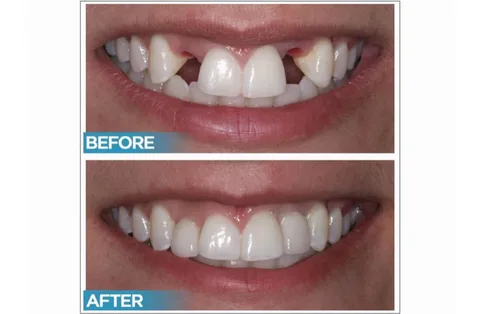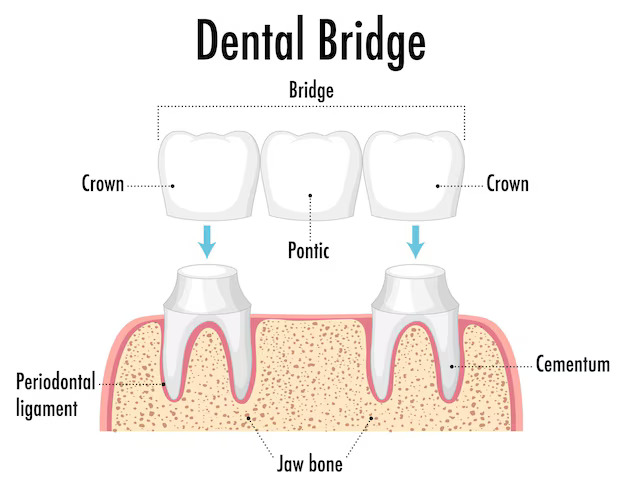Dental Bridge
Dental bridge is a fixed prosthetic device used to replace one or more missing teeth by bridging the gap between adjacent teeth or dental implants. It restores the function and appearance of the teeth, helping maintain oral health and preventing further complications caused by tooth loss.
A dental bridge is a reliable and effective solution for replacing missing teeth, improving oral health, and restoring a confident smile. Consulting with a dentist helps determine the best type of bridge for individual needs.
How a Dental Bridge Works
A dental bridge is essentially a structure composed of:
- Artificial Teeth (Pontics): These are the replacement teeth that fill the gap. Pontics are custom-designed to resemble natural teeth in size, shape, and color.
- Supporting Elements (Abutments): These are the neighboring teeth or dental implants that anchor the bridge. Abutments can be natural teeth that are prepared and capped with crowns or titanium implants embedded in the jawbone.
The bridge is designed to distribute the biting and chewing forces across the abutments and ensure the proper alignment of the jaw.
Detailed Types of Dental Bridges
Traditional Dental Bridge:
- The most common type.
- Requires natural teeth on both sides of the gap to be prepared for crowns.
- Ideal for single or multiple adjacent missing teeth.
Cantilever Bridge:
- Anchored to only one abutment tooth.
- Suitable for areas under less stress, such as front teeth.
- Less stable compared to a traditional bridge.
Maryland Bridge (Resin-Bonded Bridge):
- Uses a framework of metal or porcelain bonded to the back of adjacent teeth.
- Minimal preparation is required, preserving the natural teeth.
- Best for replacing a single missing tooth in the front of the mouth.
Implant-Supported Bridge:
- Supported by dental implants rather than natural teeth.
- Requires surgical placement of implants, which act as the roots for the bridge.
- Extremely durable and suitable for replacing several missing teeth in a row.
Materials Used for Dental Bridges
Dental bridges can be made from a variety of materials, chosen based on functionality, aesthetics, and patient preference:
- Porcelain or Ceramic: Offers a natural look and is commonly used for visible teeth.
- Porcelain-Fused-to-Metal (PFM): Combines the strength of metal with the natural appearance of porcelain.
- Zirconia: Known for its strength, durability, and natural appearance.
- Metal (Gold or Alloys): Very durable and resistant to wear but lacks aesthetic appeal.
- Composite Resin: Affordable but less durable compared to other materials.
When is a Dental Bridge Recommended?
A dental bridge is typically recommended for:
- Replacing Missing Teeth: Especially if the gap is flanked by healthy teeth.
- Improving Chewing and Speaking: Restores functionality lost due to missing teeth.
- Preventing Teeth Shifting: Adjacent teeth may drift into the gap, causing misalignment.
- Maintaining Jaw Structure: Reduces bone loss by evenly distributing bite forces.
Step-by-Step Procedure
- Initial Consultation:
- A dentist examines the patient’s teeth and gums, discusses options, and takes X-rays to assess the underlying bone structure.
- Preparation:
- For traditional bridges, abutment teeth are reshaped to fit crowns.
- For implant-supported bridges, implants are surgically placed and allowed to integrate with the bone.
- Impression:
- A mold or digital scan is taken to ensure the bridge is custom-fitted.
- Temporary Bridge:
- A temporary bridge may be placed while the permanent one is being fabricated.
- Placement:
- The permanent bridge is fitted, adjusted, and cemented into place.
Key Feature about Dental Bridge

Restores Smile and Aesthetics

Restores Functionality

Prevents Teeth Shifting
Frequently asked questions
Here are descriptions for FAQs about Dental Bridge to provide a clear understanding:
A dental bridge is a fixed dental prosthesis used to replace one or more missing teeth by bridging the gap with artificial teeth, supported by adjacent natural teeth or implants.
With proper care, a dental bridge can last 10–15 years or longer, depending on the material and oral hygiene.
The main types are:
- Traditional Bridge: Anchored to crowns on both sides.
- Cantilever Bridge: Anchored to one tooth.
- Maryland Bridge: Bonded to adjacent teeth with a framework.
- Implant-Supported Bridge: Anchored by dental implants.
The procedure is generally painless, as it is done under local anesthesia. Some sensitivity or discomfort may occur after the procedure but resolves quickly.
- Brush and floss daily.
- Use a water flosser or special floss for cleaning under the bridge.
- Visit the dentist regularly for check-ups and cleanings.
